No~Shock~Zone Part 10: GFCI testing
A deep dive into advanced testing of GFCI nuisance tripping
GFCI review
If you don’t already know what a GFCI (Ground Fault Circuit Interrupter) circuit breaker is, please read my article HERE on basic theory and operation of this lifesaving device. GFCI devices are among the least understood of all electrical safety circuits, but their function is really pretty simple once you understand their basic operating principles.
It’s all about balance
Here’s the illustration we used in Part 8 to demonstrate what a GFCI is looking for electrically. Note that a perfectly isolated electrical appliance should have exactly the same amount of electrical current going out and coming back in. For example, if an appliance draws 7.000 amperes of current from the black/hot wire, then exactly 7.000 amperes of return current should be coming back in the white wire. However, if there’s any secondary connection to the earth/ground from something like our happy camper poking a piece of metal in a socket while standing on the ground, there will now be more current going out the black wire than is returning from the white wire.
Class-A GFCI breakers in America are designed to trip when there’s any more than 5 milliamperes (5/1000 of an amp) of difference between the black and white wires. Note that a GFCI breaker doesn’t really need the green/ground wire at all to function. The GFCI detector circuit only cares about what’s going out of the black wire compared to what’s coming back into the white wire.
Nuisance tripping
What bothers many campers and homeowners about GFCI breakers is that they’ll occasionally trip for no apparent reason. So if you plug your shore power to the GFCI outlet in your garage to run your RV refrigerator while you’re stocking for an extended trip next week, you may come back the following day to find the power out and your food spoiled. Nobody was in the RV and nothing looks out of place. Or you plug in a power drill to your exterior RV outlet and BAM! – it trips before you can pull the trigger on the drill. Why would that happen when the drill runs just fine in your basement workshop? Those sorts of situations are what make home and RV owners suspicious of GFCIs and want to replace them with a non-protected outlet – which, I might add, is illegal to do.
Less than perfect?
What could cause an appliance or electrical circuit to behave badly and fool a GFCI into tripping? Glad you asked. Every appliance has at least two separate wires connecting it to the power outlet, and many will have a third “green” wire known as the safety ground. The purpose of this ground wire is to drain off any electrical leakage within the appliance itself that might occur from deteriorated insulation, a pinched wire or perhaps a failed component such as a power transformer or light bulb socket with water inside.
This deterioration or component failure often occurs in old electrical appliances. So if you’re plugging in a Fender guitar amp from your teenage years, the amplifier probably has a lot of heat damage to the power transformer from those extended bar jams of “Smoke on the Water.” That overheating is what causes that peculiar “burnt transformer” smell that we also associate with a bad fluorescent light ballast.
An appliance’s or amplifier’s insulation breakdown doesn’t always result in a complete short circuit that would trip a regular 20-amp circuit breaker. It can be like a small leak in a pipe that’s dripping water just a bit. So let’s assume that there’s 10 milliamperes of electrical leakage from the hot/black wire of the power cord to the chassis of your amplifier. That’s way less than the 3 or 4 amperes of current your amp is drawing from the circuit to run the tubes and power the speakers. Therefore, a 20-amp circuit breaker thinks that all is well.
However, plug that same guitar amplifier into a GFCI breaker and it sees there are 4.010 amperes of current going to the black wire and only 4.000 amperes of current coming back from the white wire. Where did those extra 10 milliamperes (0.010 amps) of current go? Well, back through the green wire that ties to the white wire way back at the electrical panel. But since the GFCI doesn’t know or care if that extra 10 mA of current was properly disposed of via the green ground wire or your hand touching the electrified chassis of the amplifier, it trips the breaker in an attempt to save your life. Let’s not call this nuisance tripping, but rather life-saving tripping.
Charting fault combinations
So here are two ways to determine which of your appliances is tripping the GFCI. The first is pretty simple. Just unplug every appliance from its own electrical outlet and begin plugging them back in one at a time and turning them on. You’ll want to cycle the appliance on and off a few times since there can be ground fault current “spikes” when you turn on a microwave or light switch.
But here’s where it gets tricky: ground fault currents are additive. So if you have two appliances that are each leaking 4 mA (milliamperes) of current to ground, turning on either one of them won’t trip your GFCI, but turning on both appliances at the same time will allow their fault currents of 4 mA and 4 mA to add up to 8 mA. And, of course, 8 mA is greater than the 5 mA limit of the GFCI breaker so it trips.
This might require a little detective work, but I usually make a simple chart or spreadsheet of all my appliances and turn them on singly and in combination with every other possible appliance. Charting seems like an unnecessary step, but that’s when you’ll see obvious combinations that cause a problem, like in my chart above. It shows that when I turned on both the porch light and the microwave, the GFCI would trip. Now I know there’s something electrically leaking to ground in both the porch light and microwave. The porch light might have a water leak in the wall, which is letting moisture into an unsealed electrical box, while the microwave could have a chafed wire from bouncing down the highway for the last few years. Both problems should be corrected since they’ll only get worse, not better, with age.
Measure it
There is, however, an even better method if you’re an RV tech or can borrow or buy a clamp-on ammeter such as the Fluke shown in the picture. To do this properly you’ll need a meter that can display down to 0.001 amperes, which is 1 mA resolution. Clamp-on ammeters have a current transformer that looks for current flowing through the wires placed inside their jaws. However, if you simply clamp them around the entire power cord of an appliance, you’ll be summing the current going out from the black wire with the currents returning from the green and white wires and you won’t know the actual ground leakage current. Because the GFCI ignores the green wire current in its own leakage calculations, we need to do the same thing with our clamp-on ammeter to get the real current levels involved.
You can do this ground fault leakage test by sacrificing a short extension cord to make a test cable. (Don’t you feel like a scientist, now?)
With the extension cord unplugged from everything, just slit off the outer covering, being careful not to nick the insulation of the black, white or green wires. Get rid of any nylon filler and untwist the group of wires until you get something that looks like the picture to the right.
This is perfectly safe to use for testing, but because you’ve removed the outer protective layer of insulation, you’ll need to retire this particular extension cord from your regular hookup inventory. That why I typically do this modification to a short 6-ft. extension cord which I then keep on my test bench.
This modification allows you to plug your appliances one at a time into a non-GFCI outlet using your test cable to see how much current is leaking back to ground.
Clamp the ammeter around the black (hot) and white (neutral) wires as shown in the picture, keeping the green (ground) wire out of the jaws. or alternately, you can clamp the meter around the green ground wire. Either way will yield the same results.
Your ammeter will now be registering how much current is going out the black wire minus how much is coming back in the white wire. So any currents you read on the meter will be the ground leakage that can cause the GFCI to trip from that appliance. Or if you’ve clamped around the green ground wire you’ll be reading the amount of current leaking to the EGC ground wire, which will be the outgoing current minus the incoming current. Pretty neat!
Note that there’s going to be a certain amount of leakage to ground from anything plugged into a wall outlet. So less than 1 mA is not a problem. If you have a high resolution clamp meter like this one ($1,000+) you can read down to 0.1 mA of resolution, showing 0.0008 amps which is 0.8 mA of current flow, just less than 1 mA. That by itself shouldn’t cause a GFCI to trip. But you can see that if you have five appliances plugged into a single GFCI (like a campsite 20-amp receptacle) and each appliance is leaking around 1 mA of current to ground, and since 5 times 1 mA = 5 mA total leakage current, that GFCI breaker is going to trip whenever it feels like doing so.
Now, if you don’t have an expensive clamp ammeter like mine that registers down to 0.1 mA of current, all is not lost. Most clamp meters under $100 will only register current down to 0.01 Amps which is 10 milliamps. To increase its resolution all you have to do is wrap the green wire in your test cord around the jaw of any clamp meter 10 times, and that will amplify the sensitivity of the meter by a factor of 10. So with a 10X wrap when your meter is reading 10 mA of current (0.01 amp) there’s actually only 1 mA (0.001 amp) of leakage current, and a reading of 30 mA (0.03 amp) on your clamp meter is actually only 3 mA (0.003 amp) of leakage current from your appliance, etc. Neat trick, eh?
One way to check your entire RV for GFCI leakage current is to use a 15-amp dogbone adapter to plug it into this short test cord with all your RV circuit breakers and appliances off. Then turn on one circuit breaker and appliance at a time and monitor the amount of leakage current you’re seeing on the clamp meter. With the exception of the converter/inverter (which by code can leak up to 3 mA to ground and still be within limits), any other appliance in your RV which leaks over 1 mA of current to ground (reading 10 mA or 0.01 on your meter with the 10X modification) is suspect and should be evaluated for internal power supply ground–leakage problems and probably replaced.
Sorry, but troubleshooting each appliance for what’s causing its own ground fault leakage is beyond the scope of this article, but once you’ve identified the problem, you can either replace or repair each item, checking again with your clamp-on ammeter to confirm you’ve fixed the current leak to ground. Once your RV’s total ground leakage current is below 5 mA, then your random shore power GFCI tripping should become a thing of the past.
Wrap up
GFCI breakers nearly always trip for a reason, and that reason is that they see an imbalance between how much current is going out to an appliance from the black wire compared to how much is coming back in from the white wire. If you clamp an ammeter around the black and white wires at the same time, any current flow detected will be ground leakage within the appliance itself. Over 5 mA of leakage to ground is supposed to trip a residential GFCI, so it’s only doing its job.



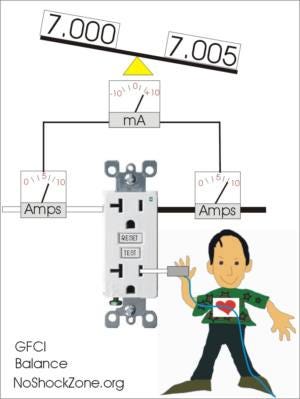
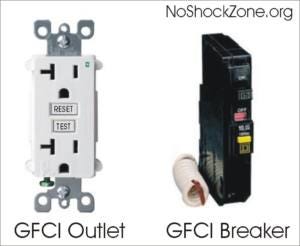

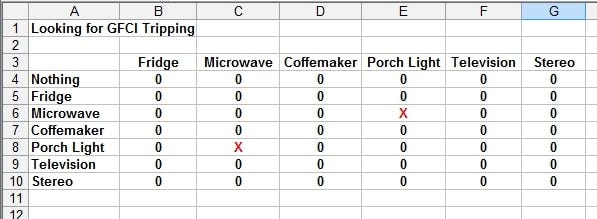
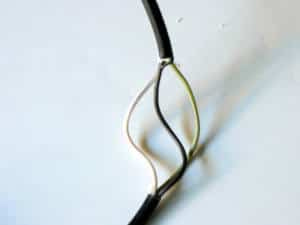

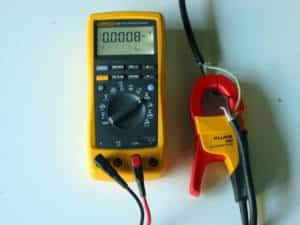
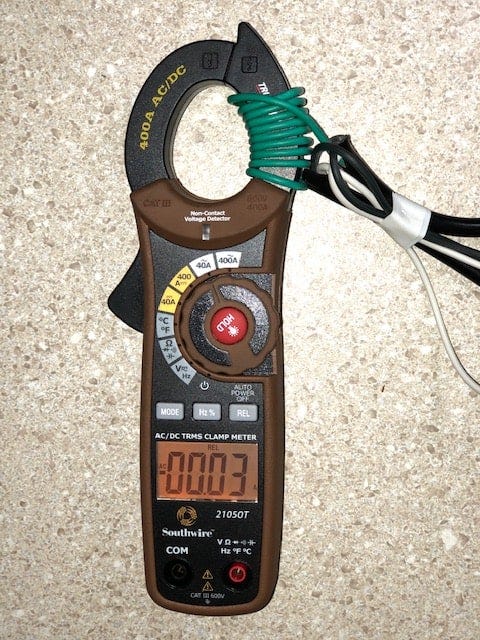

Thanks…
Nice article. Please note that many AC noise/lightning suppressors including UPSs use capacitors from black to earth and white to earth (green). The currents should be balanced, but not always. Ul allows around a mA to flow to earth. Each filter adds. Even if an appliance is new, it could be a contributor.